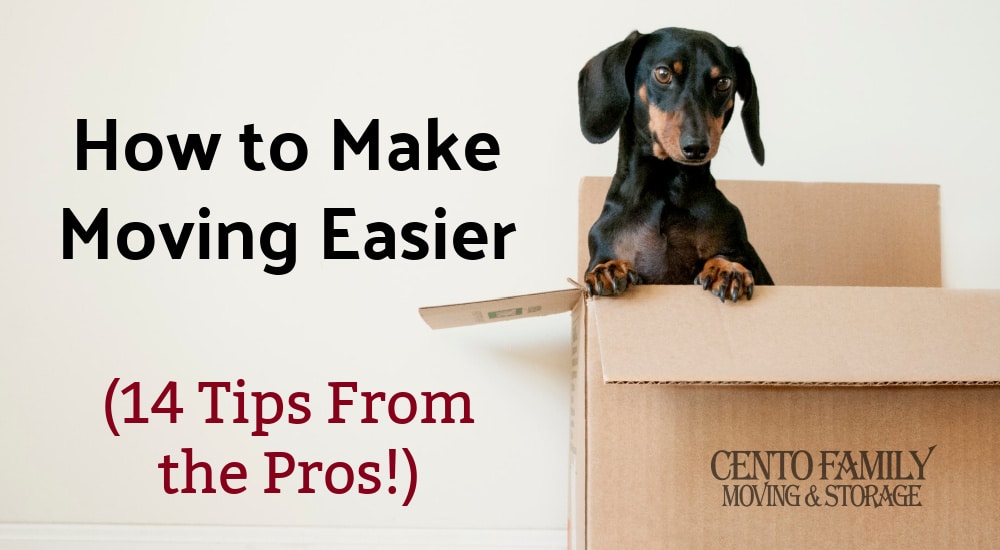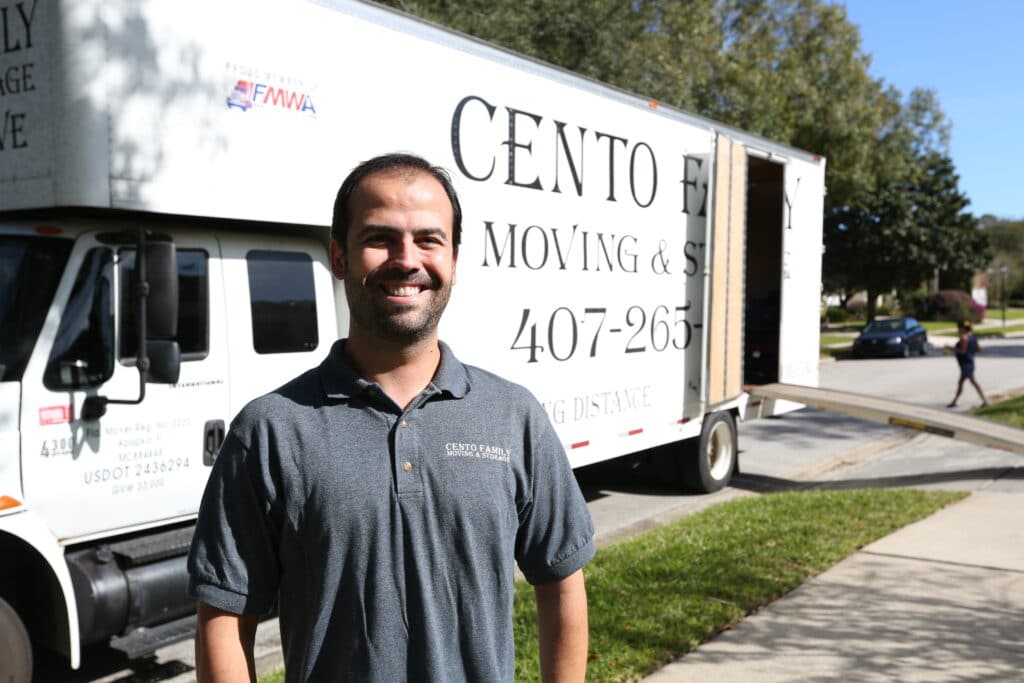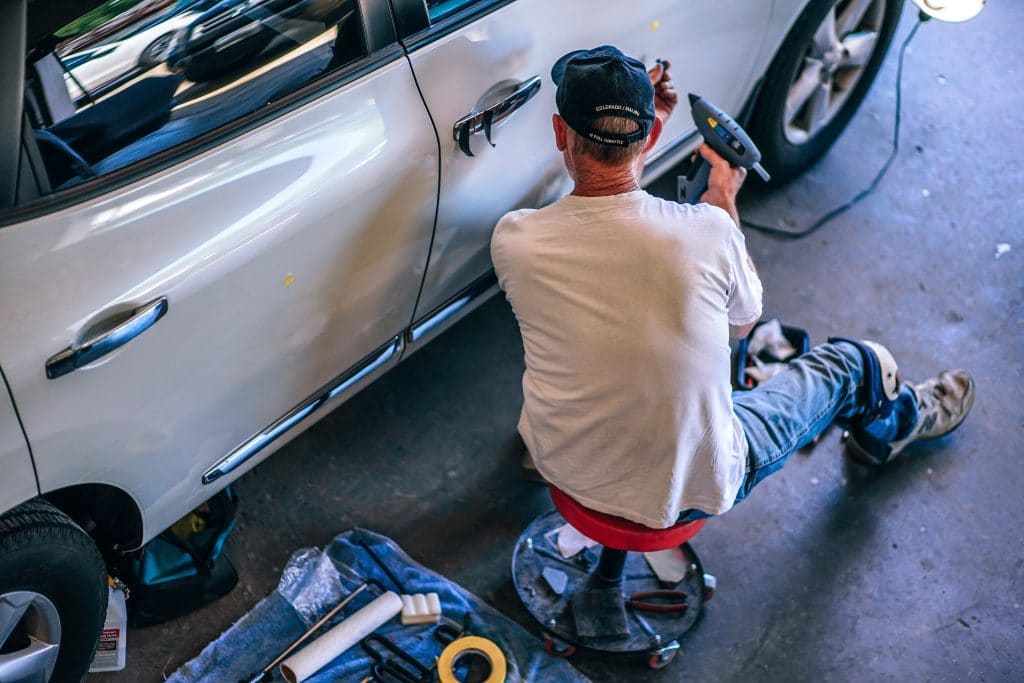How to Make Moving Easier (14 Tips From the Pros!)

The moving process can be a huge pain.
Good news! The pros know how to make moving easier.
It happens to everyone at some point. You begin to outgrow that starter home you purchased after your wedding. The kids have all moved out and your home is too much for you to handle. Maybe your job is relocating you to another state.
Whatever the reason, you have to move.
And you’re not looking forward to it.
Hey, we get it. (Not everyone loves moving as much as we do.) But we’ve learned a few things over the years and that experience has given us some moving tips, tricks, and advice that we can share with you.
Figuring out how to make moving easier doesn’t have to be tricky. We’ve compiled 14 of our best moving tips to get you packed up, shipped out, and moved in with the least amount of stress.
Hang in there. You got this.
1. Make a Moving Binder
It doesn’t matter whether you’re moving across town or across the country, relocating involves a lot of moving parts. And all that paperwork can get out of hand if you’re not prepared for it.
Enter: the moving binder.
A moving binder is as simple as it sounds. Fill a three-ring binder with all the resources you need for your move. You can make it as fancy or as streamlined as you like, just as long as it suits you and has space for everything you’ll need.
Some helpful things to include in your moving binder are:
- A calendar to note important dates and deadlines
- Checklists, inventory lists, and other to-do lists (see #3 below)
- Rental agreements (if applicable)
- Mortgage paperwork
- Utility service paperwork
- Moving company quotes
- School information
- Realtor info
This isn’t an exhaustive list; every move is different, so feel free to include what works for you.
Once everything is organized, you’ll know exactly where to find things when you need them (and where to put them once you’ve finished). And once you move into your new place, you already have a binder that includes all of the relevant information.
You might never need it, but on the off chance you need to return to some piece of information from the move, it’s nice to know everything is all in one place.

Hire Movers
It should come as no surprise that moving companies know all the tips and tricks on how to make moving easier. But before you hire any movers, decide what level of service is best for you and your family and make sure that the company you choose is reliable.
Do you need someone to handle the packing and moving? Make sure you hire a moving company that offers packing services. Are you able to move all of your stuff to your new home, or will you need to rent a storage unit? Your moving company might have a storage facility that is the perfect fit. Or maybe you’re moving cross country? You’ll need to make sure that the company will be using their own moving truck (you want to know exactly who is handling your long distance move).
This decision will be based on your budget as well as lifestyle. If you’re in a rush and simply won’t have time to collect packing supplies, wrap everything in bubble wrap, and research those packing hacks you saw on Pinterest, you may find it easier to have the movers pack everything for you.
Next, make sure to get at least three written quotes from licensed movers in your area. Read reviews. Check that they aren’t moving brokers. Compare prices, levels of service, and insurance coverage. All companies should have some type of minimum coverage, but it can’t hurt to ask about full value coverage for your expensive items. It might cost less than you’d expect.
It’s also a good idea to ask the moving company what its rules are. Some moving companies will only move things in boxes, for example. And all moving companies are legally prohibited from moving flammable materials, cleaning products, and other chemicals. Knowing this ahead of time helps you plan (and pack) accordingly.
Last but not least, ask if they are members of any professional movers associations and check out their ratings with the Better Business Bureau. Unfortunately, there are scammers out there, so also check with your state’s Department of State to verify they are licensed as a mover.

3. Declutter
Moving is the perfect chance to turn over a new leaf. So be like Marie Kondo and ask yourself, “Does this item bring me joy?” If it does, then keep it. If it doesn’t, then it doesn’t come with you.
Decluttering your house before a move sounds like a lot of work, but it’ll save you time in the long run. Moving companies typically base their quotes on either how much stuff they’ll be moving or the amount of time it will take to complete the job.
Either way, rather than paying someone to haul that old couch you hate, you could get rid of it (or sell it and make a few bucks).

4. Make a List
Staying on top of your move means knowing—and doing—everything that needs to be done.
And you can’t do that without lists.
Start with a moving timeline checklist to make sure you stay on track and don’t procrastinate. Things will only get more time-sensitive as you get closer to moving day, so get as much done in advance as possible.
It’s also helpful to create an inventory list of everything you’ll be packing. It sounds tedious, but it’s one of the only ways to keep track of everything. By creating a hard list (print it out, but also keep a copy on a cloud-based storage system), you’ll know if something goes missing or gets stolen.
Your inventory list should include the number and condition of your items, as well as which box they are in (label those cardboard boxes as you pack so you don’t get confused).
If the moving company uses an inventory list, ask to approve it. That way, there’s no discrepancies over what condition your items were in before the crew touched them.

5. Pre-Arrange the Furniture
While you can’t always move your furniture a month ahead of time and start setting things up, that doesn’t mean you have to leave everything till the last minute.
Find a floor plan of your new home or apartment (that’s in your moving binder, right?) and spend some time brainstorming about how you would like the furniture arranged.
Most floor plans have dimensions listed, so you’ll know right off the bat whether that couch will even fit on the wall across from the fireplace or whether all of Harper’s furniture will fit into her new room. (If you know that certain items won’t fit, you can get rid of them and save yourself the hassle of paying to have them moved.)
Knowing where everything will end up saves time on moving day, since you won’t have to hem and haw over where the bookcase should go. Just make sure to communicate your plan to the team so everything goes where it’s supposed to.

6. Change Your Address
About a month before you move, swing by the post office or visit the USPS website and fill out a change of address form. This free service will ensure that you still get all of your mail delivered, even if you forgot to notify someone of your move.
But just to be safe, you should also update any other relevant parties with your new address. Send out a blast email to friends and family. Notify the landscapers, your credit card companies, and the government through the appropriate pathways.
For services like utilities and cable, make sure they will be turned on at the new place the day before moving in and turned off at your old address a day or so after moving out. You don’t want to face moving day with no lights or—even worse—no air conditioning.

7. Start Packing Early
The sooner you start packing, the sooner you’ll be finished.
No matter what size your current place is, you own plenty of things that you won’t need between now and moving day. Out-of-season clothes, rarely used kitchen appliances, books, art, and decorative items can all be packed up without disrupting your daily routine.
You don’t want to still be shoving things in boxes when the movers show up, so don’t leave packing to the last minute.
Start with one room or one cabinet at a time to prevent yourself from feeling overwhelmed and set aside anything you know won’t be coming with you to the new house.

8. Pack Smarter
Hiring movers to pack up your belongings is the best way to make moving easier. But if that’s not in your budget, here are a few packing tips from the pros.
- Use high-quality materials to prevent damaging your items during transport. (Those used cardboard boxes from the grocery store won’t cut it.)
- Pack heavy items in small boxes and lighter items in bigger ones. This will prevent you from getting injured.
- Don’t pack air! Fill up the empty spaces in your boxes with linens, clothing, and other lightweight items (they’ll double as padding).
Need more detailed moving and packing tips? Check out the “Packing Room By Room” series on our blog.

9. Visit the Mechanic
If you’re making a long-distance move (and not shipping your car) or if you’re moving to an area with different weather or terrain, it’s a smart idea to get your car serviced and tuned up before you hit the road.
You might be tempted to forego this step so you can tackle all the more pressing items on your to-do list, but when your car breaks down on I-95, you’ll wish you had taken care of it when you had the chance.

10. Keep it Organized
As the old saying goes, “an ounce of prevention is worth a pound of cure.”
By organizing your move during the packing and planning stages, you’ll save yourself a huge headache on moving day.
When packing, label your boxes with their contents as well as what room they’re going to. If you’ll be arranging things differently in your new place, this might mean taking items from different rooms in your old house and packing them into a single box.
If you want to go a step further, number or color code (with different colors of duct tape) your moving boxes according to what room they’ll be going into. Your moving crew will be able to tell right away what goes where.
It’s also a good idea to label each room in your new home, so the moving crew won’t have to wonder which upstairs bedroom is “Dylan’s Room.” A simple sign next to the doorway is enough, just make sure it’s legible and matches the wording on the box.
This might make packing take a bit longer (you started early, though, didn’t you?), but the unpacking process (a step most people procrastinate) will be a breeze.

11. Make Yourselves Comfortable
“Moving into a new house” doesn’t usually top most people’s favorite tasks, but there are ways of making a hectic and strenuous process easier.
Set up an easily accessible station with drinks and snacks for your family, friends, or the moving crew to take as needed. Not only will you work up a sweat (and an appetite) coordinating the move, but it’s likely that your fridge and pantry items will have already been eaten, thrown out, or packed up.
Make sure there’s plenty of water so everyone can stay hydrated, and stick with snacks that will fuel a long day. Granola bars, jerky, trail mix, and dried fruit are all healthy options that won’t need to be refrigerated or prepped before you can eat them.

12. Pack a Moving Essentials Kit
That first night in your new place tends to be a little stressful…especially if you have to dig through all those boxes just to find your toothbrush and pjs.
To avoid this (and get to sleep a little sooner), pack a moving essentials kit for each member of your household, including pets. Having your toiletries, entertainment, and comfort items in one place makes the first 24 hours a lot less stressful.

13. Hire a Sitter
If you have pets or young children, moving day might seem like a nightmare.
Open doors, people coming in and out, your belongings in disarray…all of it poses a risk of your babies getting loose or hurt in the hubbub. Not to mention the risk of them getting underfoot and tripping someone.
If you can, arrange for a pet sitter or babysitter to watch them for the day. Perhaps Grandma or a family friend would be happy to step in.
If you don’t have anyone handy, set up an out-of-the-way spot where kids and pets can hang during the move. Babies can be worn in a carrier or nap in a playpen in an empty room. Pets can go into a bathroom to wait it out. Set older children up with a movie, iPad, or anything else that holds their attention.
Pick another room to serve as a second holding area, so you can unload the truck without worrying about stepping on any toes—or tails.

14. Keep It Clean
Since your new place will be in disarray for the first few days (or weeks), you probably won’t find time to clean. But in fact, the best time to clean is before you move in.
With no furniture or knick-knacks to move out of the way, it will be easier and quicker to get everything spic and span.
If you’re short on time, hire a professional cleaning service to tackle it a few days before you move in. Most maid services offer move-in and move-out cleanings in addition to their regular service. If you’re going to take care of it yourself, do a thorough job and maybe take care of a few minor repairs while you’re at it.
Conclusion
Just the thought of organizing a move can cause most people a lot of stress, but if you know how to move easier, you can avoid the hiccups that often disrupt a move.
These top moving tips will help you get back to your daily routine as quickly as possible. And if you’re planning an office move, it’s even more crucial to be properly prepared so your business isn’t disrupted! With early preparation and an organized process, your move can be seamless, harmless, and stress-free.
Cento Family Moving & Storage has moved households just like yours into, out of, and within Central Florida while maintaining a reputation of honesty, integrity, and care.
If you are planning a move, please contact us for a free quote so that we can show you how easy moving can be.
Recent Posts
- The Ultimate Guide to Packing Office Equipment April 12, 2024
- How to Find a Reliable Mover (and Avoid Scams!) April 5, 2024
- How Much Does It Cost To Move (Without a Moving Company)? March 13, 2024








